Skye Terrier
 Skye Terriers
Skye Terriers
The first Terrier of Scotland to be named in the English Stud Book, the Skye Terrier of today is easily recognized by his glamorous coat. But don't be fooled - they are a one-man dog, suspicious of strangers so must always be approached with caution. Their long body sits on short, strong legs. They come in two different ear types, pricked or dropped, with the pricked being more common.
History of the Skye Terrier
 Skye Terrier (with Fox Terrier) 1896
Skye Terrier (with Fox Terrier) 1896
Many believe the Skye is Scotland's oldest Terrier breed. These short-haired terriers have been used for otter drags and fox hunting have been documented on the Isle of Skye off the coast of Scotland since the 1500's. They accompanied hounds, keeping as near to them as their short legs would allow.
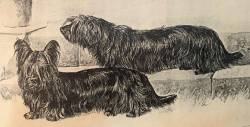 Skye Terriers c 1890
Skye Terriers c 1890
After the hounds had driven the fox or otter into their den within the rocks, the terriers were sent in. So, the terrier had to be small and flat in the rib to enable him to successfully undertake these subterranean manœuvres, which he often had to accomplish lying on his side. He must also have courage sufficient to face and kill his quarry, or die in the attempt[1].
The Skye Terrier becomes a Pure Breed
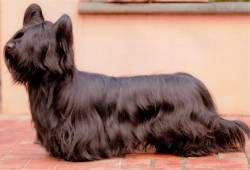 Skye Terrier
Skye Terrier
It is well documented that Queen Victoria acquired a Skye on her first visit to Scotland with her husband, Prince Albert in 1842. From then, she owned several Skyes as depicted in various famous paintings, particularly those of Sir Edwin Landseer. This did much to promote the Skye Terrier in England as a companion[2].
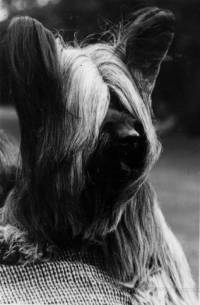 Skye Terrier
Skye Terrier
When the Skye Terrier first emerged as a pure breed, there were two separate Breed Standards. One for the Skye Terrier Club of Scotland and the other for the two English Clubs. These were the Skye Terrier Club of England and the Skye and Clydesdale Club.
As these Breed Standards differed, it is surprising that correct breed type was ever established! The Scots required a smaller dog, weighing under 20 pounds with the coat no longer than 5.5 inches, and a total body length of 40 inches. However, the English allowed an additional 5 pounds in weight, 44 inches in body length with a coat of 9 inches![1a]
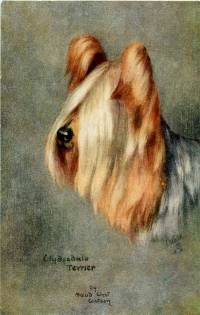 Clydesdale Terrier
Clydesdale Terrier
The Clydesdale (or Paisley) Terrier (now extinct)
The emergence of the Skye Terriers as a pure breed is complicated by a similar long-haired glamorous breed becoming known in the late 1870's. Called the Clydesdale (or Paisley) Terrier, his appearance was no doubt influenced by the Yorkshire Terrier. These dogs had long, straight, silky body coats without undercoat. They were always steel blue in colour, with the heads, legs and feet a bright rich tan free from dark hairs. Their demise was due to their terrier-like attitude, combined with a coat that was too difficult to maintain[1b]. It was also stated:
Essentially a ladies' companion and pet, the Anglo-Saxon does not look for or appreciate anything effeminate coming from the land of the hardy Celts!
History of Skye Terriers in Australia
 Skyes with the 1911 Cup
Skyes with the 1911 Cup
Skye Terriers were first imported into Melbourne in 1880 with 29 Skyes (Prick-Eared) and three Skyes (Drop-Eared) arriving here by 1911[3]. That year the cup pictured was awarded to the Best of Breed Drop eared Skye owned by G S Sanderson in Tasmania for a dog called 'Agrippa Dunskye'[3]. But Skyes died out here after that until the 1960's.
Then the late Maureen Cartledge began breeding Skyes under the 'Santlin' prefix. Her first dog was 'Dane Hills Jock', bred by Mrs McGlyn of NSW. He was the son of 2 English imports, Ch Rhoseigr Blond Ever out of Merry Mount Only Wait. Since then, Santlin Skyes have produced a myriad of big winning Champion Skye Terriers across Australia spanning 6 decades[5].
Comparison between the Skye and Scottish Terrier
|
Skye Terrier |
Scottish Terrier |
|
| General Appearance | Long and low; twice as long in length as height at shoulder | Thick-set, of suitable size to go to ground, great power and activity in small compass |
| Temperament | One-man dog, distrustful of strangers | Bold, but never aggressive |
 Skye Terrier Skye Terrier |
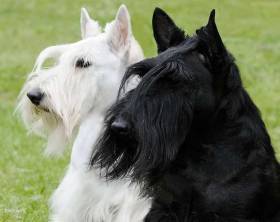 Scotties (Wheaten & Black) Scotties (Wheaten & Black) |
|
| Head | Long and powerful, strength not to be sacrificed for extreme length | Head long with skull and muzzle of equal length |
| Skull | Moderate width of back skull | Long enough to be fairly wide yet retain narrow appearance |
| Stop | Slight | Moderate |
| Muzzle | Strong | Strong and deep throughout |
| Eyes | Preferably dark brown, medium size and close set | Dark brown and almond shaped, set fairly wide apart under eyebrows |
| Ears | Pricked or dropped. When pricked not large but gracefully feathered, erect at outer edges with inner edges sloping towards the skull. When dropped lying flat and close at the front | Must be pricked. Neat (not large) fine (thin) textured and set on top of the skull not too close together |
| Mouth | Normal scissors bite | Normal scissors bite |
 Skye Terrier Skye Terrier |
 Scottish Terrier Scottish Terrier |
|
| Neck | Long with a slight crest | Moderate length and muscular |
| Shoulders | Broad | Broad |
| Forelegs | Short and muscular and work close to the body with the feet required to point straight forwards | The forelegs must be well boned and straight right through the pasterns. The forelegs must not be out at elbow nor placed under the body. Instead the elbows work beside but clear of the ribcage |
| Chest | Deep but not excessive. If the chest is too deep, the forelegs would have to bend around it and therefore not point forwards | Fairly broad and deep and when viewed in profile, the brisket extending in front of fore legs and hung between them. |
| Body | Long and low with a level back. Sides appear flat due to the straight falling coat. | The ribcage is long with the ribs well rounded but flattening out towards the chest. The topline of the back is short, straight and level with a muscular deep loin. |
| Hindquarters | Well muscled and angulated. Legs short muscular and straight when viewed from behind, with no dewclaws. | Remarkably powerful for the size of the dog with big wide buttocks. Hocks short and strong neither turning in or out. |
| Feet | Front feet larger than the hind and pointing forwards. Pads thick and nails strong. | Front feet slightly larger than the hind, with thick pads and well arched toes. |
| Tail | At rest, the upper part hangs pendulous with the lower part pointing backwards, away from the dog in a scimitar-shaped curve. When moving the tail is carried as an extension of the topline, but not above. | Of moderate length to balance the dog but never docked. Thick at the root and tapering towards the tip. Set high leaving the topline in either a vertical or a somewhat forward position. |
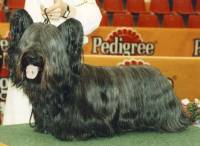 Skye Terrier Skye Terrier |
 Scottish Terrier Scottish Terrier |
|
| Gait | Free, active and effortless giving a fluid look. | Smooth and free, moving straight fore and aft with a level topline. |
| Coat | Double coat with a short, close and woolly undercoat and an outer coat of reasonable length lying straight and flat, free from curl, and never impeding action. Coat on head shorter, never obscuring either the vision or the shape of the ears. | Close lying double coat with a short dense soft undercoat and a dense and wiry outer coat, thatched together to make a weather resisting jacket. |
| Colour | Black, dark or light grey, fawn or cream, all with black points | Black, wheaten or brindle of any shade |
| Size | 25 - 26 cm (10 inches). Tip of nose to end of tail 105 cms (41.5 inches). Bitches slightly smaller | Height: 25 - 28 cm (10 - 11 inches) Weight: 8.5 - 10.5 Kg (19 - 23 pounds) |
BREAKING NEWS.
We have now published a unique Terrier book 'Terriers Unveiled' Available at our sister site: https://rangeairevision.com/terriers-unveiled/
References and Further Reading
[1] Captain W Wilmer and R Leighton 'The Skye Terrier' Cassell's New Book of the Dog' by Robert Leighton assisted by eminent authorities on the various breeds Published by The Waverley Book Co Ltd Vol 111, Chapter XLIII Page 407
[1a] Ibid Page 408
[1b] Ibid Page 414
[2] Sine Threlfall, 'The World of Dogs Skye Terrier' Published by Kingdom Books England 1995, ISBN 85279009-1 Part 2 Show Dogs of Great Britain Page 57
[3] T.W.Tyzack and C.S. Turner "Tyzack's Annual" published by the Victorian Poultry and Kennel Club, printed by Bellmaine Bros., Printers 66 - 70 Flinders Lane Melbourne Australia P. 77 - 78 (Stud Book) and 99 (Importations)
[4] Theo Marples FZS 'Show Dogs' Published by 'Our Dogs' Publishing Co., Manchester 1903 Chapter L.1 Page 238
[5] Many thanks to David and Julie Cartledge for their assistance with page